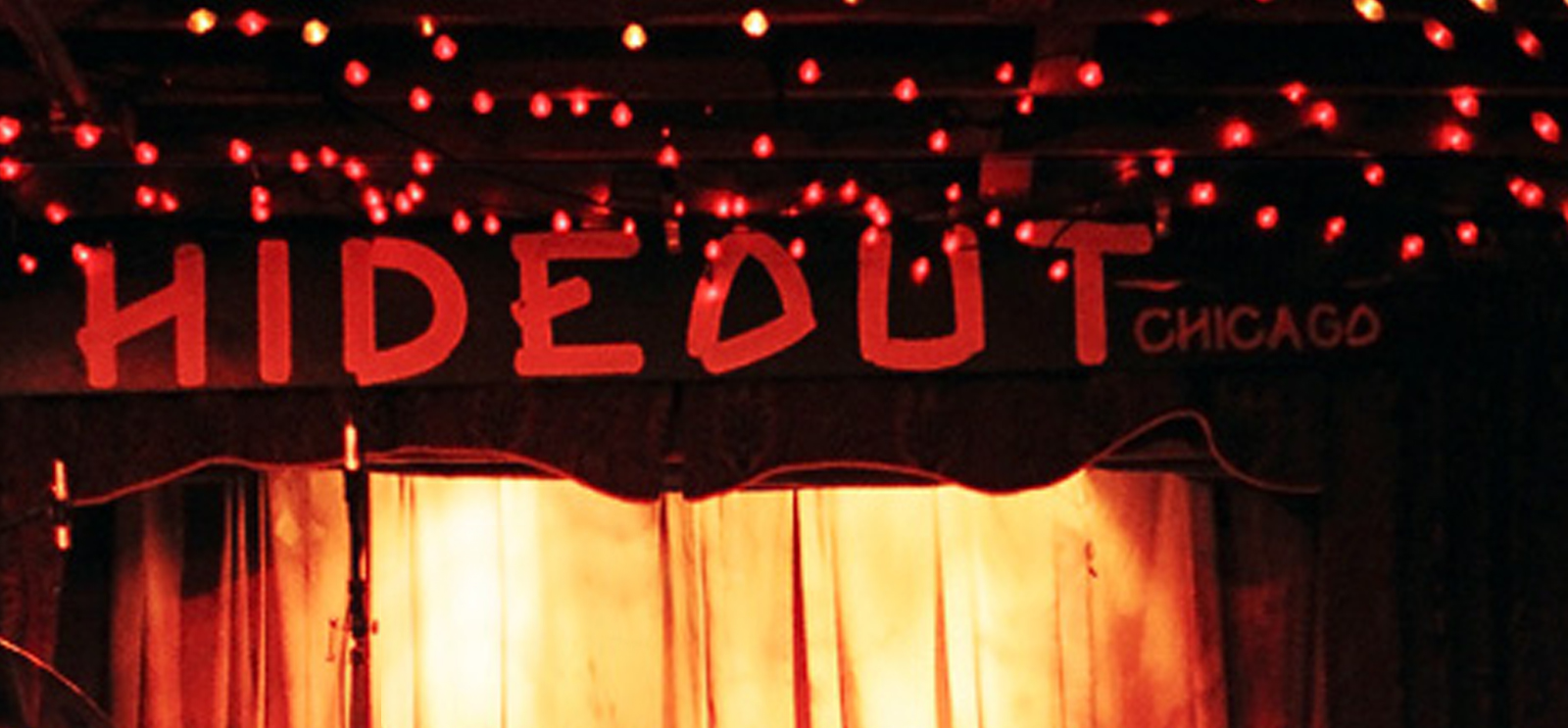
Hideout. (Photography by JuicyRai, CC BY-NC-ND 2.0)
A Study Chicago excursion to the Hideout.
Last spring the College ran the Study Chicago quarter for the first time. Inspired by the College’s Study Abroad offerings, the Study Chicago program included courses in history, literature, and public policy, as well as group excursions on Fridays. Lecturer Paul Durica, AM’06, PhD’13, scheduled additional excursions for his literature class, including this Monday afternoon trip.

There’s no dress code at the Hideout, a small, unprepossessing club at 1354 West Wabansia in West Town.
Nonetheless Bill Savage and Dmitry Samarov, slouching on adjacent barstools, are wearing the same gray T-shirt, featuring an ink drawing of a manhole cover.
 The drawing is Samarov’s. Savage wore his shirt as an homage, not realizing Samarov would make the same sartorial choice.
The drawing is Samarov’s. Savage wore his shirt as an homage, not realizing Samarov would make the same sartorial choice.
It’s the last meeting of the course Representing Chicago: The City in Art, Literature, and Music, taught by Paul Durica, AM’06, PhD’13.
One of Durica’s students had asked if there were a modern-day version of the Dill Pickle Club, a popular literary hangout founded in 1914. So Durica decided to hold class at the Hideout.
 He’s invited Samarov to talk about his illustrated memoir Hack: Stories from a Chicago Cab (University of Chicago Press, 2011). Savage is there not only as Samarov’s editor but also as the editor of the annotated edition of Nelson Algren’s Chicago: City on the Make (University of Chicago Press, 2011).
He’s invited Samarov to talk about his illustrated memoir Hack: Stories from a Chicago Cab (University of Chicago Press, 2011). Savage is there not only as Samarov’s editor but also as the editor of the annotated edition of Nelson Algren’s Chicago: City on the Make (University of Chicago Press, 2011).
Savage and Durica have worked together too. They coedited a new edition of Chicago by Day and Night: The Pleasure Seeker’s Guide to the Paris of America (University of Chicago Press, 2013), originally written for visitors to the 1893 World’s Columbian Exposition.
In the back room, an unseen band is rehearsing. Durica wonders aloud if he should start. “It’s your class, dude,” says Savage.
[[{"type":"media","view_mode":"media_original","fid":"3430","attributes":{"alt":"","class":"media-image","height":"257","typeof":"foaf:Image","width":"500"}}]] A spot illustration from the original Chicago by Day and Night. (Public Domain)

When the Hideout opened in 1890, Durica tells the class (shouting a little over the band), this was a manufacturing area and it was a bar for laborers. Algren lived on Wabansia Avenue as well, though his section no longer exists because of the interstate.
The band launches into “Summer Nights” from (coincidentally) the Chicago musical Grease.
“What was the literary scene like in the 1940s?” Durica asks Savage.
“Divided and multiple, like today,” Savage says.
“Tell me more, tell me more,” the band sings encouragingly.
 Algren couldn’t publish novels in the 1950s, Savage explains (to the class, not the band), as society became more conservative. He “just barely” made a living as a writer. He would have come to places like this. The music probably would have been jazz.
Algren couldn’t publish novels in the 1950s, Savage explains (to the class, not the band), as society became more conservative. He “just barely” made a living as a writer. He would have come to places like this. The music probably would have been jazz.
A student asks about the obscure references in City on the Make.
“Which is why we did the annotated edition,” says Savage. The piece was originally written for the October 1951 issue of travel magazine Holiday, he notes, holding up a copy. Gwendolyn Brooks wrote a similar essay on Bronzeville.

The discussion turns to Hack. “What makes it a Chicago text?” a student wants to know.
“I found out it was a Chicago book after I wrote it,” says Samarov. “Nobody outside Chicago seemed to give a shit about it. Whether I set out to write a Chicago book or not, I certainly wrote one.” He took notes, he tells another student, by text message and Twitter.
The conversation circles back to Algren. “What attracted artists to this part of the city?” Durica asks.
“It was cheap,” says Savage. “And these were the marginalized people he wanted to write about. By the way, Algren never would have called it Wicker Park. It was the Near Northwest Side.”
This comment inspires Samarov to reminisce about his own time living in Wicker Park as an art student in the early 1990s. When a neighborhood gentrifies, he says, “first the art kids move in, then the gay people, and then it’s safe for yuppies.” The students laugh uproariously, having evidently never heard this urban truism before.

Savage, an Algren devotee and a teacher himself, throws out a question to the students. “Someone pick a favorite line from City on the Make.”
There’s a terribly awkward moment of dead air. Even the band stops playing.
Finally someone makes the anodyne observation that the book is like a love letter to Chicago.
“Do you think of your book as a love letter to Chicago?” Savage asks Samarov.
“Yeah,” says Samarov.
The discussion veers to the current mayor. Savage shares an unprintable story or two. The students look impressed.
“Let’s get back on track.” Durica says.
“Did we go off track?” says Samarov.
“Was there a track?” says Savage.
